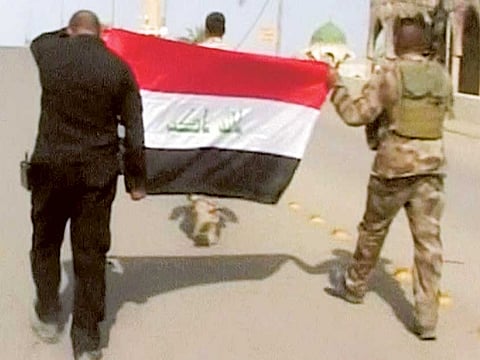Daesh militants on the run in Syria and Iraq
Iraqi forces recapture key Daesh stronghold Fallujah on Sunday after declaring victory in the city a week earlier

Baghdad: Iraqi commanders announced the complete recapture of key Daesh stronghold Fallujah on Sunday after declaring victory in the city a week earlier.
Here is a recap of key cities and towns retaken from Daesh in Iraq and neighbouring Syria:
Iraq
FALLUJAH: Anbar province’s second city and one of Daesh’s most emblematic bastions in the country, located just 50 kilometres from Baghdad. It was seized by anti-government fighters in 2014 and later became a key Daesh stronghold.
While the battle has been won, Iraq still faces a major humanitarian crisis in its aftermath, with tens of thousands of people who fled the fighting desperately in need of assistance in the searing summer heat.
Daesh seized Ramadi, located 100 kilometres (60 miles) west of Baghdad, in May 2015 in an assault involving dozens of suicide bombers driving explosives-rigged vehicles. Iraqi forces launched an operation to retake the city late last year and declared full control over the area earlier this year.
TIKRIT: Hometown of late Iraqi dictator Saddam Hussain located 160 kilometres north of Baghdad, it was the second city after Mosul to fall to Daesh. It was recaptured in April 2015 by Iraqi troops, police and Shiite-dominated paramilitaries. The operation, which was at that time the largest by Iraqi forces against Daesh, was helped by the fact that much of Tikrit’s civilian population had fled the city.
SINJAR: Iraqi Kurdish forces backed by US-led coalition air strikes recaptured Sinjar, 400 kilometres northwest of Baghdad, from Daesh last November. That cut a key supply line linking areas held by the terrorists in Iraq and Syria. Daesh captured Sinjar in August 2014 and carried out a brutal campaign against its Yazidi minority that included massacres, enslavement and rape.
BAIJI: Iraqi forces recaptured the town of Baiji, 200 kilometres north of Baghdad in October 2015. Baiji and the country’s largest refinery, located nearby, were the scenes of some of the longest-running battles with Daesh in Iraq. The town lies at a major crossroads and its recapture was seen as key to preparing the ground for offensives in Anbar and Mosul, the last major Iraqi city held by Daesh.
Syria
PALMYRA: Known as the “Pearl of the Desert”, Palmyra was overrun by Daesh in May 2015, after which the terrorists blew up UNESCO-listed temples and looted ancient relics.
Syrian regime forces backed by Russian warplanes and allied militia retook the ancient city from Daesh in March this year.
KOBANI: A Kurdish town in northern Syria on the Turkish border. It became a symbol of the fight against Daesh, and the terrorists were driven out of Kobani in January 2015 after more than four months of fierce fighting with Kurdish forces backed by US-led strikes.
The city, known in Arabic as Ain Al Arab, is the capital of one of three semi-autonomous “cantons” established by Kurds after the Syrian war erupted.
TAL ABYAD: Another city on the Turkish border, it was captured by Kurds in June 2015. Tal Abyad lies on a key supply route between Turkey and Daesh stronghold Raqa, and terrorist fighters and arms regularly passed through the city before its recapture.
Sign up for the Daily Briefing
Get the latest news and updates straight to your inbox


